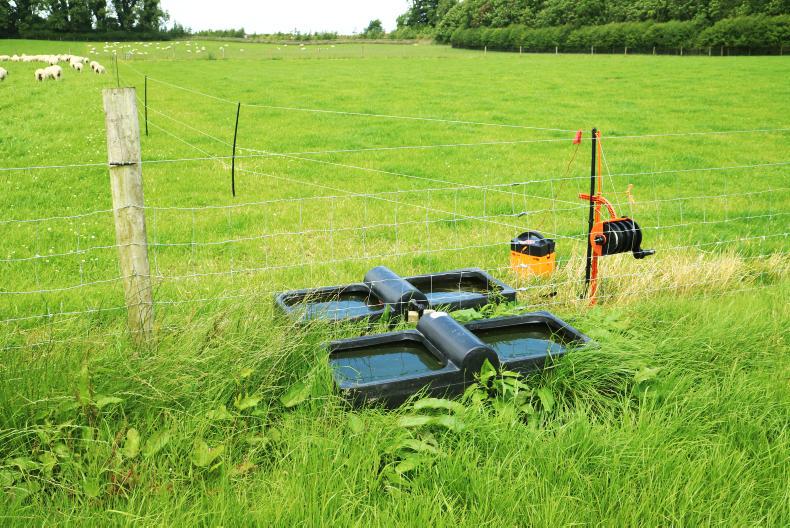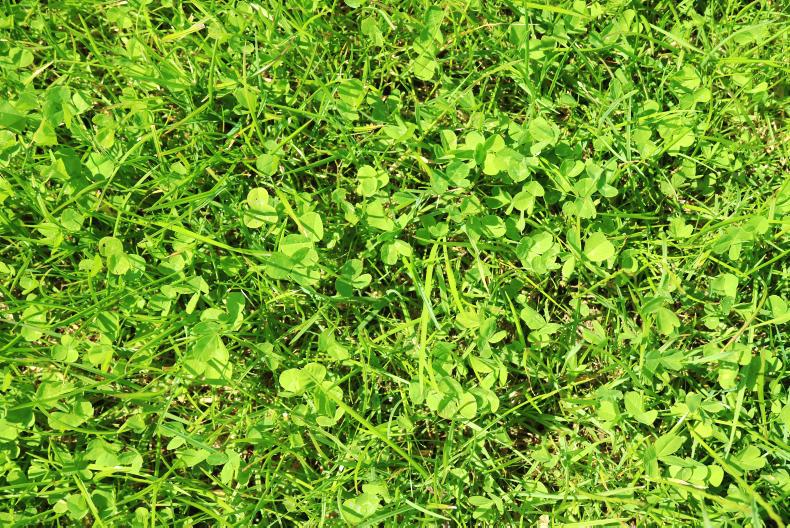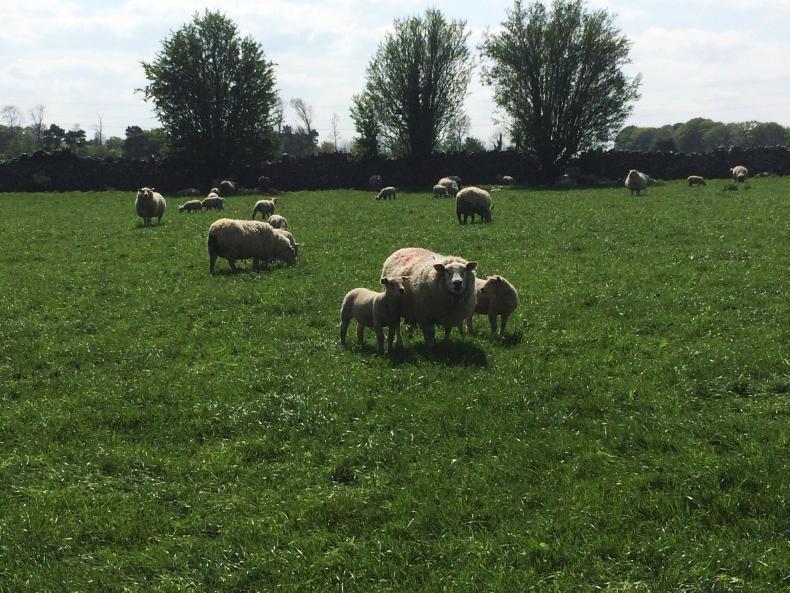Grass growth rates are rapidly rising this week following a jump in temperatures. The sharp rise may be stifled in some areas due to low soil moisture levels but for the majority of producers, management practices put in place this week and next will be crucial to maintaining swards at optimum condition for grazing over the coming months.
 Grass growth rates in the Teagasc Athenry research demonstration flocks in Mellows Campus have been holding steady in recent weeks at a range of 40kg DM/ha to 50kg DM/ha, but jumped to 72kg DM/ha in the last week. Flock researcher Philip Creighton expects peak growth rates to arrive in the coming week and as such management practices are focused on maintaining sward quality.
Grass growth rates in the Teagasc Athenry research demonstration flocks in Mellows Campus have been holding steady in recent weeks at a range of 40kg DM/ha to 50kg DM/ha, but jumped to 72kg DM/ha in the last week. Flock researcher Philip Creighton expects peak growth rates to arrive in the coming week and as such management practices are focused on maintaining sward quality.
Swift action
A number of paddocks amounting to about 15% to 20% of each grazing area with strong grass covers of 2,000kg DM/ha to 2,500kg DM/ha were taken out of the rotation on Tuesday and the aim will be to get these baled in the next week to 10 days. This will serve a number of goals. Harvesting quickly at a low cover will ensure rapid sward recovery and get paddocks back into the rotation. It will also ensure excellent quality grass at a critical stage pre-weaning when lamb performance rates are often at risk of dipping as lambs move to a predominately grass-based diet.
Also, harvesting grass at this stage is an opportunity to make excellent quality baled silage which can be used in late pregnancy to reduce concentrate demand.
Strong opening covers
Grass management this year has been hugely different to 2016 when inclement weather hit performance and interfered with normal lamb drafting rates across most sheep farms. Philip explains that favourable growth during the closed period resulted in the farm’s opening covers being higher than normal. Above-normal growth rates at the end of March boosted supplies and led to management changes being put in place much earlier to try and maintain grass quality.
“We reseeded about 20% of each farmlet last autumn as part of our move to the grass/clover trial. It looked like some of this area might fail initially, due to the poor weather conditions in September, but we got it back on track and grazed in October and again in December.

“This really took off at the end of March and with good grass supplies and some heavy covers already present we were probably a week to 10 days later going into the second grazing rotation. We introduced strip wires and subdivided paddocks earlier and this was a big help in grazing swards down from 4.5cm to 3.5cm/4cm, which was the greatest challenge to achieve. The last 15% of the rotation was good quality and we took a decision to leave this ungrazed and close for silage at the start of April.”
This helped get grazing back on track and another 10% was removed from the rotation in mid-April to give a total of 20% to 25% of each farmlet removed for the main crop of silage. The latter area received 70 units of nitrogen and is on track for cutting at the end of May to achieve high-digestibility silage for feeding over the main winter housing period. The end of May cutting date is also strategic to have high-quality aftergrass swards available for grazing post-weaning.
Back on track
A major factor helping grass last longer this year is the high levels of utilisation being achieved with one of the greatest challenges, as mentioned above, being to graze out paddocks sufficiently. Now firmly back on track, ewes and lambs are entering paddocks of 1,200kg DM/ha to 1,400kg DM/ha.
Splitting paddocks remains critical in balancing the amount of time animals spend in paddocks and the post-grazing height achieved. Growth rates will be monitored closely and further decisions on taking additional areas out of the rotation will be taken on the back of the weekly grass budget.
Health concerns
The only health concerns at present are with nematodirus and scald. Lambs received a white drench for nematodirus a couple of weeks ago but Philip says a further treatment may be required in a couple of weeks, with some lambs at a young age at the first treatment. Faecal egg counts will also be collected more regularly from next week and this will help decide when the first worm dose is required.
Outside of this, the only other health concern is scald in some lambs. This has been quickly treated by running lambs through a footbath solution of 10% zinc sulphate.
New direction
The research demonstration flock is taking a new direction and while prolificacy and stocking rate will remain focal points, the emphasis is turning to what level of performance can be achieved by incorporating clover into the swards. Philip explains that there are three treatments being explored:
Grass-only swards with 145kg/ha nitrogen input.Grass/clover swards with 145kg/ha nitrogen input.Grass/clover swards with 90kg nitrogen input.
The treatments are being explored across two stocking rate levels of 11 ewes/ha and 13 ewes/ha, with medium (weaning 1.5 lambs plus) and high (weaning 1.7 lambs plus) prolificacy groups persisting.
“We got useful results from the previous stocking rates of 10 ewes, 12 ewes and 14 ewes/ha. The 10 ewes had a lot of capacity to push on while the stocking rate of 14 ewes per hectare was probably a step too far and the additional inputs required cancelled out the merit of exceeding beyond 12 ewes/ha. Hopefully we will be able to drive grassland on a bit more by incorporating clover and for that reason we are using two stocking rates of 11 ewes/ha and 13 ewes/ha.”
Philip adds that clover swards are delivering positive results in a dairy context and it will be interesting to see if these can be replicated in sheep systems.
“Performance is positive in dairying and in theory we should also get similar in grass-based sheep systems. There are question marks, however, around if 25% clover content is the optimum level and how clover will persist in the sward given the tighter grazing nature and dense swards. It will be of real interest to see if clover in the low nitrogen input swards can fix enough nitrogen to match sward performance in the higher input systems and also to see if we can finish more lambs off grass.”

Grass growth rates are rapidly rising this week following a jump in temperatures. The sharp rise may be stifled in some areas due to low soil moisture levels but for the majority of producers, management practices put in place this week and next will be crucial to maintaining swards at optimum condition for grazing over the coming months.
 Grass growth rates in the Teagasc Athenry research demonstration flocks in Mellows Campus have been holding steady in recent weeks at a range of 40kg DM/ha to 50kg DM/ha, but jumped to 72kg DM/ha in the last week. Flock researcher Philip Creighton expects peak growth rates to arrive in the coming week and as such management practices are focused on maintaining sward quality.
Grass growth rates in the Teagasc Athenry research demonstration flocks in Mellows Campus have been holding steady in recent weeks at a range of 40kg DM/ha to 50kg DM/ha, but jumped to 72kg DM/ha in the last week. Flock researcher Philip Creighton expects peak growth rates to arrive in the coming week and as such management practices are focused on maintaining sward quality.
Swift action
A number of paddocks amounting to about 15% to 20% of each grazing area with strong grass covers of 2,000kg DM/ha to 2,500kg DM/ha were taken out of the rotation on Tuesday and the aim will be to get these baled in the next week to 10 days. This will serve a number of goals. Harvesting quickly at a low cover will ensure rapid sward recovery and get paddocks back into the rotation. It will also ensure excellent quality grass at a critical stage pre-weaning when lamb performance rates are often at risk of dipping as lambs move to a predominately grass-based diet.
Also, harvesting grass at this stage is an opportunity to make excellent quality baled silage which can be used in late pregnancy to reduce concentrate demand.
Strong opening covers
Grass management this year has been hugely different to 2016 when inclement weather hit performance and interfered with normal lamb drafting rates across most sheep farms. Philip explains that favourable growth during the closed period resulted in the farm’s opening covers being higher than normal. Above-normal growth rates at the end of March boosted supplies and led to management changes being put in place much earlier to try and maintain grass quality.
“We reseeded about 20% of each farmlet last autumn as part of our move to the grass/clover trial. It looked like some of this area might fail initially, due to the poor weather conditions in September, but we got it back on track and grazed in October and again in December.

“This really took off at the end of March and with good grass supplies and some heavy covers already present we were probably a week to 10 days later going into the second grazing rotation. We introduced strip wires and subdivided paddocks earlier and this was a big help in grazing swards down from 4.5cm to 3.5cm/4cm, which was the greatest challenge to achieve. The last 15% of the rotation was good quality and we took a decision to leave this ungrazed and close for silage at the start of April.”
This helped get grazing back on track and another 10% was removed from the rotation in mid-April to give a total of 20% to 25% of each farmlet removed for the main crop of silage. The latter area received 70 units of nitrogen and is on track for cutting at the end of May to achieve high-digestibility silage for feeding over the main winter housing period. The end of May cutting date is also strategic to have high-quality aftergrass swards available for grazing post-weaning.
Back on track
A major factor helping grass last longer this year is the high levels of utilisation being achieved with one of the greatest challenges, as mentioned above, being to graze out paddocks sufficiently. Now firmly back on track, ewes and lambs are entering paddocks of 1,200kg DM/ha to 1,400kg DM/ha.
Splitting paddocks remains critical in balancing the amount of time animals spend in paddocks and the post-grazing height achieved. Growth rates will be monitored closely and further decisions on taking additional areas out of the rotation will be taken on the back of the weekly grass budget.
Health concerns
The only health concerns at present are with nematodirus and scald. Lambs received a white drench for nematodirus a couple of weeks ago but Philip says a further treatment may be required in a couple of weeks, with some lambs at a young age at the first treatment. Faecal egg counts will also be collected more regularly from next week and this will help decide when the first worm dose is required.
Outside of this, the only other health concern is scald in some lambs. This has been quickly treated by running lambs through a footbath solution of 10% zinc sulphate.
New direction
The research demonstration flock is taking a new direction and while prolificacy and stocking rate will remain focal points, the emphasis is turning to what level of performance can be achieved by incorporating clover into the swards. Philip explains that there are three treatments being explored:
Grass-only swards with 145kg/ha nitrogen input.Grass/clover swards with 145kg/ha nitrogen input.Grass/clover swards with 90kg nitrogen input.
The treatments are being explored across two stocking rate levels of 11 ewes/ha and 13 ewes/ha, with medium (weaning 1.5 lambs plus) and high (weaning 1.7 lambs plus) prolificacy groups persisting.
“We got useful results from the previous stocking rates of 10 ewes, 12 ewes and 14 ewes/ha. The 10 ewes had a lot of capacity to push on while the stocking rate of 14 ewes per hectare was probably a step too far and the additional inputs required cancelled out the merit of exceeding beyond 12 ewes/ha. Hopefully we will be able to drive grassland on a bit more by incorporating clover and for that reason we are using two stocking rates of 11 ewes/ha and 13 ewes/ha.”
Philip adds that clover swards are delivering positive results in a dairy context and it will be interesting to see if these can be replicated in sheep systems.
“Performance is positive in dairying and in theory we should also get similar in grass-based sheep systems. There are question marks, however, around if 25% clover content is the optimum level and how clover will persist in the sward given the tighter grazing nature and dense swards. It will be of real interest to see if clover in the low nitrogen input swards can fix enough nitrogen to match sward performance in the higher input systems and also to see if we can finish more lambs off grass.”

 Grass growth rates in the Teagasc Athenry research demonstration flocks in Mellows Campus have been holding steady in recent weeks at a range of 40kg DM/ha to 50kg DM/ha, but jumped to 72kg DM/ha in the last week. Flock researcher Philip Creighton expects peak growth rates to arrive in the coming week and as such management practices are focused on maintaining sward quality.
Grass growth rates in the Teagasc Athenry research demonstration flocks in Mellows Campus have been holding steady in recent weeks at a range of 40kg DM/ha to 50kg DM/ha, but jumped to 72kg DM/ha in the last week. Flock researcher Philip Creighton expects peak growth rates to arrive in the coming week and as such management practices are focused on maintaining sward quality. 








 This is a subscriber-only article
This is a subscriber-only article















SHARING OPTIONS: